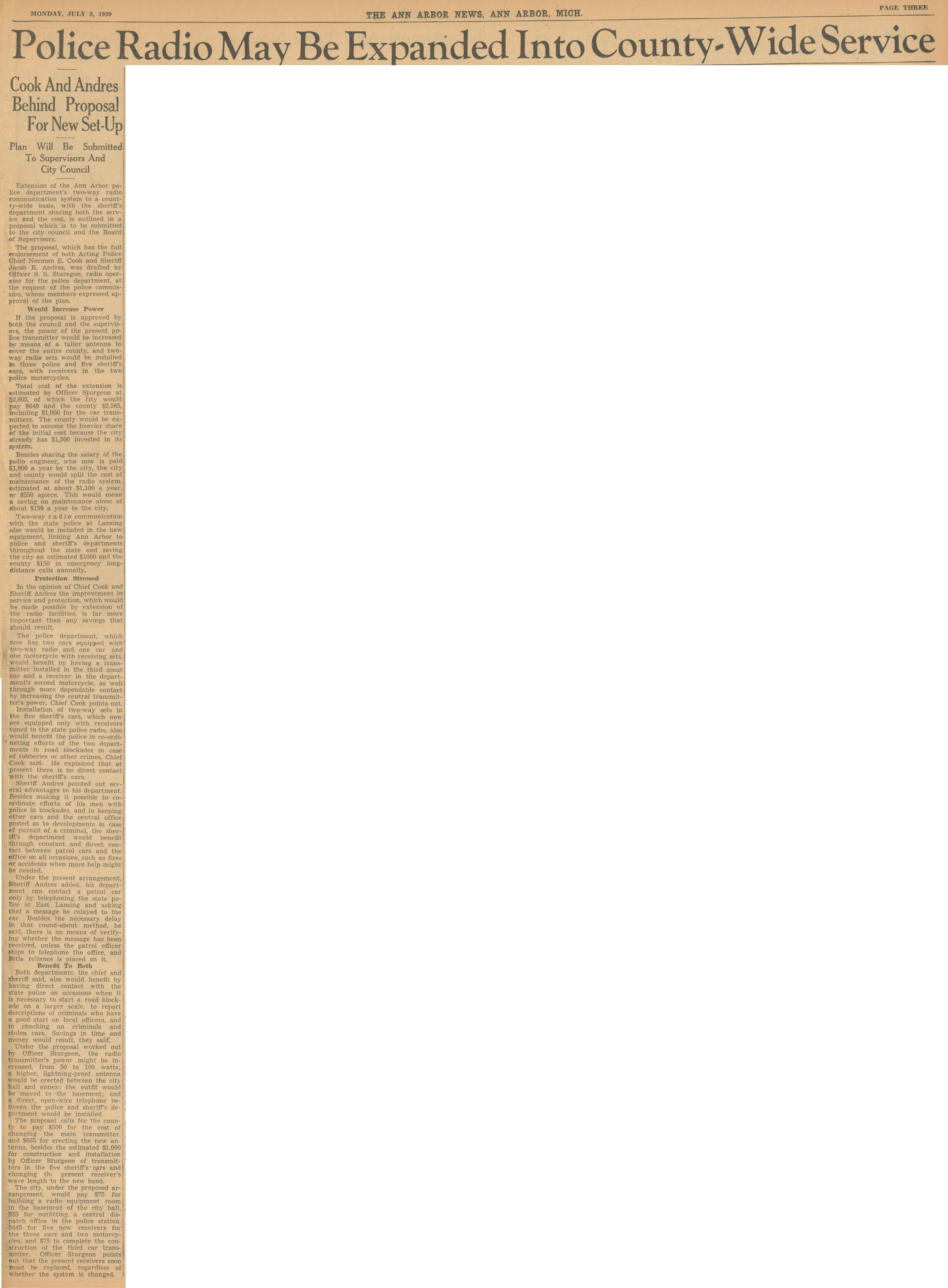Police Radio May Be Expanded Into County-Wide Service - Cook And Andres Behind Proposal For New Set-Up

Police Radio May Be Expanded Into County-Wide Service
Cook And Andres Behind Proposal For New Set-Up
Plan Will Be Submitted To Supervisors And City Council
Extension of the Ann Arbor police department’s two-way radio communication system to a countty-wide basis, with the sheriff's department sharing both the service and the cost, is outlined in a proposal which is to be submitted to the city council and the Board of Supervisors.
The proposal, which has the full endorsement of both Acting Police Chief Norman E. Cook and Sheriff Jacob B. Andres, was drafted by Officer S. S. Sturegon, radio operator for the police department, at the request of the police commission, whose members expressed approval of the plan.
Would Increase Power
If the proposal is approved by both the council and the supervisors, the power of the present police transmitter would be increased by means of a taller antenna to cover the entire county, and two-way radio sets would be installed In three police and five sheriffs cars, with receivers in the two police motorcycles.
Total cost of the extension is estimated by Officer Sturgeon at $2,805, of which the city would pay $640 and the county $2,165, including $1,000 for the car transmitters. The county would be expected to assume the heavier share of the initial cost because the city already has $1,500 invested in its system.
Besides sharing the salary of the radio engineer, who now is paid $1,800 a year by the city, the city and county would split the cost of maintenance of the radio system, estimated at about $1,100 a year, or $550 apiece. This would mean a saving on maintenance alone of about $150 a year to the city.
Two-way radio communication with the state police at Lansing also would be included in the new equipment, linking Ann Arbor to police and sheriff’s departments throughout the state and saving the city an estimated $1000 and the county $150 in emergency long distance calls annually.
Protection Stressed
In the opinion of Chief Cook and Sheriff Andres the improvement in service and protection, which would be made possible by extension of the radio facilities, is far more important than any savings that should result.
The police department, which now has two cars equipped with two-way radio and one car and one motorcycle with receiving sets, would benefit by having a transmitter installed in the third scout car and a receiver in the department’s second motorcycle, as well through more dependable contact by increasing the central transmitter’s power, Chief Cook points out.
Installation of two-way sets in the five sheriff’s cars, which now are equipped only with receivers tuned to the state police radio, also would benefit the police in co-ordinating efforts of the two departments in road blockades in case of robberies or other crimes, Chief Cook said. He explained that at present there is no direct contact with the sheriff's cars.
Sheriff Andres pointed out several advantages to his department. Besides making it possible to coordinate efforts of his men with police in blockades, and in keeping other cars and the central office posted as to developments in case of pursuit of a criminal, the sheriff's department would benefit through constant and direct contact between patrol cars and the office on all occasions, such as fires or accidents when more help might be needed.
Under the present arrangement, Sheriff Andres added, his department can contact a patrol car only by telephoning the state police at East Lansing and asking that a message be relayed to the car. Besides the necessary delay in that round-about method, he said, there is no means of verifying whether the message has been received, unless the patrol officer stops to telephone the office, and little reliance is placed on it.
Benefit To Both
Both departments, the chief and sheriff said, also would benefit by having direct contact with the state police on occasions when it is necessary to start a road blockade on a larger scale, to report descriptions of criminals who have a good start on local officers, and in checking on criminals and stolen cars. Savings in time and money would result, they said:
Under the proposal worked out by Officer Sturgeon, the radio transmitter’s power might be increased, from 50 to 100 watts; a higher, lightning-proof antenna would be erected between the city hall and annex; the outfit would be moved to the basement; and a direct, open-wire telephone between the police and sheriffs department would be installed.
The proposal calls for the county to pay $500 for the cost of changing the main transmitter, and $665 for erecting the new antenna, besides the estimated $1,000 for construction and installation by Officer Sturgeon of transmitters in the five sheriff’s cars and changing the present receiver's wave length to the new band.
The city, under the proposed arrangement, would pay $75 for building a radio equipment room in the basement of the city hall, $35 for outfitting a central dispatch office in the police station, $445 for five new receivers for the three cars and two motorcycles, and $75 to complete the construction of the third car transmitter. Officer Sturgeon points out that the present receivers soon must be replaced, regardless of whether the system is changed.